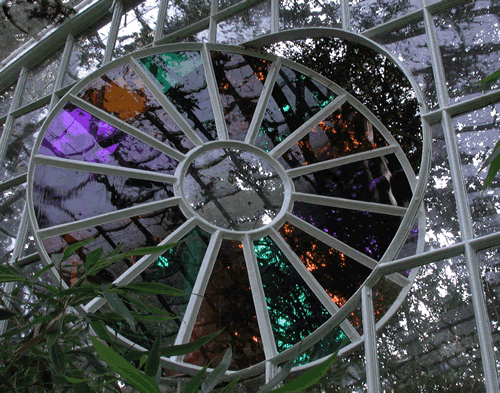Or search by topic
Number and algebra
Geometry and measure
Probability and statistics
Working mathematically
Advanced mathematics
For younger learners
Circle Panes



- Problem
- Getting Started
- Student Solutions
- Teachers' Resources
Circle Panes

Look carefully at the photo above, what do you see? What questions would you like to ask?
How many of each coloured pane are there?
How would you describe the shape of the coloured panes of glass?
How big do you think this window is?
In how many different ways could you make a sensible estimate of its size?
Talk about the different options with someone else.
Use whatever you like to make a drawing similar to what you see in the picture.
Why do this problem?
This task gives learners the chance to describe an image, using both mathematical and everyday language. The challenge of estimating the size of the window in different ways will encourage children to draw on their own experiences and make comparisons. By engaging with this problem, learners may be inspired to notice mathematics in the world around them more generally.
Possible approach
Show the photograph and invite learners to consider what they see, and what questions they would like to ask. After a few moments of silent thinking time, suggest that they talk with a partner. Bring everyone together to share their thoughts and collate a list of questions on the board which you can return to later. Encourage other members of the class to respond to the contributions rather than you validating everything that is said. At this point, learners may well use a mixture of mathematical terms and everyday language, which is very appropriate in this situation.
If it does not come up naturally, you could specifically ask about the number of coloured panes, and ways that the shape of the panes can be described. There is no mathematical term for the shape, but encourage learners to distinguish between straight and curved sides, and they may liken the shape to something else. If pupils are curious, you may wish to introduce the term 'sector', which is the area of a circle enclosed by two radii and the circumference (like the shape we often draw to represent a slice of pizza or a slice of cake), but this is certainly not obligatory! In this image, the coloured panes are not 'sectors' as each pane does not extend to the centre of the circle, but your class may come up with some informal language to describe the shape. You may wish to challenge them to describe the image to someone in another class, or another adult, who has not seen the photo. Can that person re-create the picture from just the pupils' description?
Give pupils time in pairs to think about different ways of estimating the size of the window. As they work, listen out for those who are using other items in the photo to try to get a sense of relative size, for example the leaves or the reflections that are visible. You can invite some pairs to share their thinking in the final plenary. As a simmering task (to work on over an extended period of time) you could invite learners to follow up one of the questions that was asked at the start of the lesson and then dedicate some time at a later stage for sharing findings.
Key questions
How would you describe the photo to someone else who can't see it?
How could you be more precise in your description?
What else can you see in the photo which might give some clues as to the size of the window?
Possible support
Allow learners to use gesticulation at first to help them describe what they see - this may help you focus your support in terms of vocabulary development. As they consider how to estimate the size of the window, encourage learners to look around them, both inside and outside the classroom, to identify known sizes of particular objects for comparison.
Possible extension
You could ask learners to explore the symmetry in the window.
You may also like
Four Triangles Puzzle
Cut four triangles from a square as shown in the picture. How many different shapes can you make by fitting the four triangles back together?
Playground Snapshot
The image in this problem is part of a piece of equipment found in the playground of a school. How would you describe it to someone over the phone?

